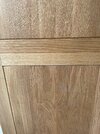The top has a few deep scratches in it and scuffs on the edge. It’s an oil finish on the top...
...My immediate thoughts are to fill it with an oak filler on the top, sand it with 180 grit and then apply a varnish to it so that it’s a bit harder wearing/wipeable to remove stains.
My immediate thought is that you've managed to make three mistakes in three thoughts...
Firstly filler never matches the timber it is supposed to and any overfilling (highly likely) will fill the pores in the oak around the scratches leaving highly visible light different coloured marks running across the table top which wiill be made even more noticeable by becoming a lighter or milkier looking area wherever the filler has contaminated the surface should you put a clear finish over the top.
Secondly, oak is an open pored timber and generally doesn't need sanding above about P120 grit. In all probability the timber has been stained at the factory, in which case you'll need to restain the area you've sanded before refinishing. Not an easy task.
Thirdly, most other finishes won't take over oil or wax finishes, so if the piece was originally oiled it's probably best to leave it as an oil finish. A plus point of oil is that it is quick and easy to apply, and easy to repair. If you really want a different finish you'll have to de-oil the top then resand it completely, working through the grits (P80 - P120) seal it with a clear shellac intercoat (because any residual oil can continate subsequent finishes) then refinish it completely
TBH it is probably better to try to disguise the scratches. Deep white scratches can be toned down using a timber repair pen (Google "Konig" and look for touch up pens). The scratch can the be filled using coloured waxes (source: Liberon, Hafele, Konig, etc) mixed to match your oak - this might require 2 or more colours to get a good match. Don't just rub the wax up and down the scratch! Instead warm the waxes for a few minutes in a mug of boiling water, pull them out (carefully) and shave off some thin scrapings of wax using a very flexible 1in stopping knife. Roll the different colour scrapings into a ball in the palm of your hand, adding different colour as required. You want to end of with a soft, warm ball of wax about the size of a pea. Scrape off small amounts of this and press them into the scratches with the stopping knife dhilst still soft. Don't overfilll - you can always build up a 2nd or 3rd layer if needed. Once the wax has cooled (only a few minutes) any excess can be scraped off using the stopping knife. This excess can be rolled into the next coloured wax pea. Having done the waxing, burnish the surface with a coarse cloth (e.g. cut up old jeans, well washed). The surface can then be re-oiled
If on the other hand the scratches are too bad - it may well be a case of resanding the entire top (starting with a P40 or possibly a P60 grit) then refinish it


